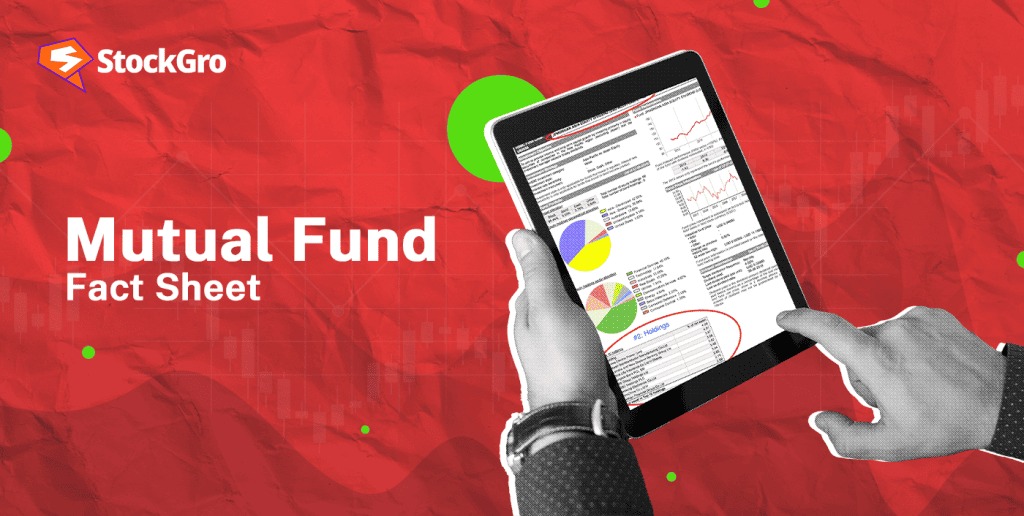
A mutual fund fact sheet is an essential investment tool. It gives an overview of the major aspects of a fund. Though the information might be a little too much to grasp initially, it has to be known in order to make the right investment decisions. This blog simplifies the task of reading a fact sheet and helps identify the key sections on which focus should be maintained, thereby enabling investors to analyse mutual funds efficiently that cater to their financial goals.
What is a mutual fund fact sheet?
A mutual fund fact sheet is a report that describes the strategy, goals, composition of the portfolio, and performance. It illustrates the “personality” of the fund, thus giving an idea whether or not it would align with a particular financial requirement and aversion to risk. Data is normally updated monthly or quarterly through fact sheets.
The Securities and Exchange Board of India (SEBI) mandates Asset Management Companies (AMCs) to maintain transparency by regularly disclosing updated fact sheets. This helps investors make informed decisions.
So where to find mutual fund fact sheets? Investors can easily access fact sheets through:
- AMC websites: Most fund houses publish fact sheets on their official sites.
- Third-party platforms: Websites like Value Research and Morningstar aggregate fact sheets for multiple funds.
- Investment apps: Several apps allow users to browse and compare fact sheets conveniently.
While both fact sheets and Scheme Information Documents (SID) offer insights into mutual funds, they serve distinct purposes:
Fact sheet: a monthly/quarterly summary focusing on performance, portfolio composition, and fund metrics. Whereas SID is a detailed document outlining the legal and operational aspects of the fund, including investment strategy, risks, fees, and terms of the scheme.
You may also like: Mutual funds or stocks: Which is a better investment?
How to read a mutual fund fact sheet?
Investment objective and strategy
The fact sheet states the objective of the fund and the strategy adopted by it to achieve that objective. Some funds invest to maximise capital appreciation or income generation. For determining whether the objective of the fund is compatible with your investment objectives and level of risk tolerance, one needs to understand the objective.
Fund manager information
Investing in a mutual fund means entrusting your money to a fund manager. Thus, it is important to check the track record of the manager. A well-experienced fund manager with a history of managing successful funds can indicate better chances of delivering consistent returns.
Tip: Check for details on the fund manager’s previous performance and their experience in managing similar funds.
Fund type and asset allocation
A fact sheet also depicts the ten major holdings, which can suggest where a fund manager places maximum reliance. Example: If two funds have diversified holdings with industries, then perhaps more stability is offered, where one is heavily weighted towards a single sector.
Performance analysis
The historical record does not ensure the future, but historical consistency from the fund offers clues. These often include returns (assuming an investment of ₹10,000 per month) for the latest periods available-for example, one year, three years, five years, and ten years so that comparison is possible.
You may also like: SIP investment: Your path to wealth building
How to use a fact sheet effectively?
It is not just scanning the mutual fund fact sheet to have a glance over the objectives and holdings. One has to work through the quantitative and volatility measures that it offers in order to make a sound investment. This will help one judge the performance of the fund, its risk level, and whether it can fit into his investment strategy. Here are a few key measures to focus on:
1. Standard Deviation (SD)
Standard deviation calculates the variance of returns of a fund over a specified period. The more the SD, the more volatile it is, and the returns of a fund are very volatile. On the contrary, lower SD reflects stable returns. This measure helps the investor decide whether he can afford that much risk, which is dependent on his time horizon and risk tolerance.
2. Total Expense Ratio (TER)
It measures the annual costs of running a mutual fund as a percentage of the assets the fund holds. It sums together management fees, administrative fees, and other expenses incurred. The lower the TER, the better; excessively high costs can be detrimental to your overall returns. You can only compare their relative merits of value for money based on TERs for like funds.
3. Beta
The responsiveness of a fund to market fluctuations is gauged by its beta. A beta of one indicates that the fund’s price will most likely follow market trends. The fund is more volatile than the market if its beta is larger than 1, and less volatile if its beta is less than 1. Beta is useful for the risk exposure view on market volatility.
4. Sharpe Ratio
It calculates a fund’s risk-adjusted return. That is to say, it computes the level of excess return received for extra volatility borne in holding a relatively riskier asset. The fund returns for the level of risk assumed increase with the ratio. This measure can therefore be highly applied in comparing funds at a different level of risk.
5. Tracking Error
Tracking error measures how closely a fund actually tracks its benchmark index. While high tracking error implies that the fund exhibits greater departures from the index, low tracking error reveals that the fund is very close to duplicating the performance of its benchmark. This measure is highly useful for index funds or ETFs because it determines how far the fund manager is able to replicate the performance of the index.
Also read: Mastering mutual fund evaluation: 5 Key metrics you need to know
Conclusion
Unless one clearly understands the important components that go into reading a mutual fund fact sheet, it can appear to be a very daunting task. It is a tool for evaluating investment choices once the objectives, performance, fees, and the manager’s expertise are aligned with financial goals. Regularly monitoring the fact sheets will help keep one updated with investments in hand and enable timely decisions based on market trends.
An informed investor is more equipped to navigate the complexities of mutual fund investing and making the right financial decisions. Start reading fact sheets today and unlock the potential of mutual funds in your portfolio!
FAQs
- What is a mutual fund fact sheet?
Fact sheets are brief summaries of critical information about mutual funds, such as their objectives, investment strategy, performance, portfolio holdings, expenses, and risks. They enable investors to decide whether a given fund matches the requirements of achieving specific goals and risk tolerance. Asset managers and funds use fact sheets to convey insights for effective advice. Periodic reviews of these sheets enable investors to track funds’ performance, know the prevailing market trends, and make adequate decisions regarding their portfolios.
- Why is it important to read a mutual fund fact sheet?
A fund fact sheet helps investors understand a mutual fund’s essential details, such as fees, risk, and historical return, and thus assess whether the fund serves their financial goals and their perceived risk. Assessing fees is significantly important, since higher fees can otherwise erode overall returns over time. The trends in the performance of funds are monitored, different funds are compared, and therefore better decisions can be made to improve their investment portfolios by frequently reviewing fact sheets.
- What key elements should I focus on in a fact sheet?
Effective reading of a mutual fund fact sheet requires that you focus on sections about fund objectives, manager details, portfolio composition, performance analysis, and key ratios. Knowing these aspects will allow you to make informed decisions by comparing the fund’s performance against benchmarks and the potential risks and rewards associated with such a fund. The overall assessment helps investors make choices on the mutual funds they can acquire depending on their finance strategy.
- How do I understand the performance data in the fact sheet?
You can watch for metrics like the Sharpe ratio and standard deviation. The Sharpe ratio measures risk-adjusted returns—higher values indicate better performance relative to risk. The standard deviation shows the fund’s volatility over time—lower values suggest more stable performance. Understanding these metrics helps investors evaluate how well a fund manages risk while generating returns, aiding in better comparisons between funds with similar objectives. These statistics are essential for assessing both performance consistency and risk exposure over time.
- What does the benchmark comparison indicate?
Benchmark will be the industry standard upon which performance can be evaluated. It is to measure, compare a fund’s strategy with broader markets or to others in its peer groups – other funds similar to industry funds. It helps give answers on such queries such as; How this mutual fund will be compared over other same categories? This fund is tracking what the markets are saying; are these fund returns appropriate for what’s occurring out in the markets?

